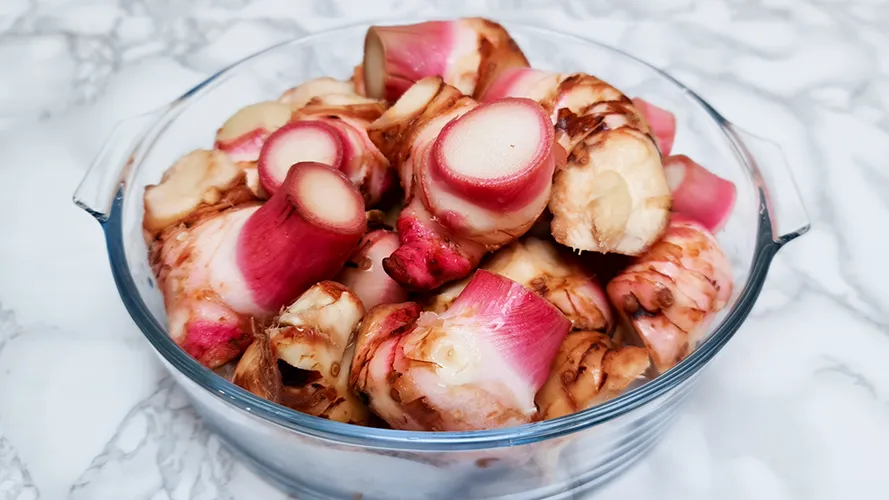Easy Way to Store Galangal for 2 Years

Galangal is an important herb in Thai cuisine. Although it’s similar to ginger in appearance, it’s very different in terms of fragrance and taste. Galangal is used in Thai soups, larb (Thai minced meat salad), or curry paste as part of the mandatory aromatic herbs and spices.
Differences between Ginger & Galangal
Although they seem similar at first glance, Galangal roots have a reddish, pinkish tint on their stems, and their skin is creamy white with streaks of dark brown or black. Ginger, on the other hand, has completely brown skin with very little colour variation.

When cut, the flesh of the galangal is off-white, while ginger’s flesh ranges from pale yellow to a sunny yellow.

In terms of fragrance, galangal is aromatic with notes of a mild minty, citrusy herb. Ginger instead carries the aroma of strong mint and overpowering heat.
This also carries over to their taste. Ginger gives off a heaty flavour, with a pungent kick. On the other hand, galangal gives off a fresh minty and lightly sour, citrusy taste. A little bite from ginger sends a numbing effect, while one has to eat a lot of galangals to get the same effect.

When to Use Galangal vs Ginger
In Thai dishes, we actually rarely use ginger. Instead, we use lots of galangals – sliced, minced or as a paste with other herbs. Ginger is most commonly used in Chinese cuisine – steamed fish, as a sauce, in a topping, or braised with meats or tofu.
Here are some recipes that use ginger:
Sliced galangal is usually added to Tom Yam or soups for their fragrance. In these dishes, their aroma plays a big part in the fragrance of the dish.

We mince our galangals when adding them to Thai larbs, or minced meat salad. For these dishes, not only are they aromatic, little bites give a very fresh feeling and lightly sour flavour.
These are some recipes that use galangal:
Steps
Storing galangal is very easy. Here’s how I do it:

- Wash and dry the galangal.
- Identify and separate young, middle and old parts.
- Slice the young and old parts thinly.
- Cover with cling wrap and set aside.

- Mince galangal with a knife or food processor.
- Portion the minced galangal into 2 tablespoons per plastic bag.
- Seal with a stapler or tape.
- Portion the young and old parts into 6-8 pieces per plastic bag.

- Seal with a stapler or tape.
- Combine all the small bags into separate large resealable plastic bags.
- Add a label with the date.
- Place in the freezer and use within 2 years.
- When it’s time to use, let the portion you need thaw for 10 minutes before cooking.

Tips
- Make sure to dry the galangal thoroughly. Moisture is an enemy of preservation – it encourages bacteria growth, which in turn, encourages decomposition.
- Slicing the galangal preserves their appearance for soup dishes. For curries and pastes, their appearance does not matter, so finely mincing them is recommended.
- If unsure what they will be used for, slice them to preserve their appearance. They can later be minced if necessary.
- Cut galangal tends to oxidise rapidly. Covering them with cling wrap slows down the process.
- Make sure to watch the full video to see how I made it exactly!
How to Store Galangal
Equipment
- Sharp Kitchen Knife
- Chopping Board
- Food Processor
Materials
- 1 kg galangal roots washed and dried
Instructions
- Identify and separate the galangal pieces into young, middle, and old parts.
- Slice young and old galangal parts thinly. Cover with cling wrap and set them aside.
- Chop the rest into small pieces. A food processor can be used to mince them finely as well. Cover with cling wrap and set them aside.
- Starting with the young galangal pieces, portion out roughly 6-8 slices into small plastic bags. Fold the flap over itself and secure it with a stapler or tape. Repeat with the old galangal parts.
- With the chopped galangal, portion about 2 tablespoons in to small plastic bags. Fold the flap over itself and secure with a stapler or tape.
- Combine each type into a larger, reusable ziplock bag. Add a label with the name and date package. Keep in the freezer.
- Before cooking, remove one portion of the desired part and thaw for about 10 minutes.
Video
Notes
Tips
- Make sure to dry the galangal thoroughly. Moisture is an enemy of preservation – it encourages bacteria growth, which in turn, encourages decomposition.
- Slicing the galangal preserves their appearance for soup dishes. For curries and pastes, their appearance does not matter, so finely mincing them is recommended.
- If unsure what they will be used for, slice them to preserve their appearance. They can later be minced if necessary.
- Cut galangal tends to oxidise rapidly. Covering them with cling wrap slows down the process.
- Make sure to watch the full video to see how I made it exactly!

Thank you very much for the tips in preserving the galangal. I am farming them at home and sourcing out from the farmers living in remote places who didn’t know what to do with their crops, then help them put them out in the market to sell. The sales proceeds, no matter how small it is, helps them buy some of their necessities. I will share to them and others these tips so people will be encourage to buy more. Agajn thanknyou so much.
Hi Anonymous, thank you so much for sharing.
I’m so happy to hear that our content can help others. I hope that this tip can help to extend and grow their businesses.
If you like, you can also apply this tip to for other herbs such as chilli, ginger, and lemongrass. Hope it helps 😀